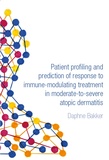Patient profiling and prediction of response to immune-modulating treatment in moderate-to-severe atopic dermatitis

Bakker, Daphne
- Promoter:
- Dr M.S. (Marjolein) de Bruin-Weller & prof.dr F. (Femke) van Wijk
- Co-promoter:
- Dr J.L. (Judith) Thijs & dr J. (Julia) Drylewicz
- Research group:
- Wijk
- Date:
- September 28, 2021
- Time:
- 16:15 h
Summary
Atopic dermatitis (AD) is one of the most common chronic inflammatory skin diseases worldwide. Due to new targeted treatments that are being developed, the treatment of AD will move towards an era of more personalized medicine. The big challenges with new treatments is to predict the most optimal treatment for the individual patient, and to monitor and prevent side effects. In this thesis we have constructed a predictive biomarker signature, which is able to identify a subgroup of difficult-to-treat AD patients in need of systemic treatment. Next, subtypes of adult and pediatric AD patients are further identified based on blood biomarker profiles, which can be helpful to find the most optimal treatment.
The thesis further focuses on clarification of early and long-term immunological effects of dupilumab, the first biologic treatment for AD, and the pathomechanism underlying different side effects. We confirm a rapid mechanism of action of dupilumab, already within two hours after the first administration. This is accompanied by a strong immunological effect after four weeks of treatment. During long-term follow-up, almost 40% of dupilumab-treated AD patients develops conjunctivitis. The majority of these patients still suffers from mild-to-moderate conjunctivitis despite ocular treatment. AD patients developing conjunctivitis during dupilumab treatment show a remarkable scarcity of conjunctival goblet cells together with a diverse inflammatory cell infiltrate.
The driving biomarker and biological pathways of the different patient clusters, together with (atopic) comorbidities, and risk factors for possible side effects that have been described in this thesis will contribute to personalized treatment strategies.